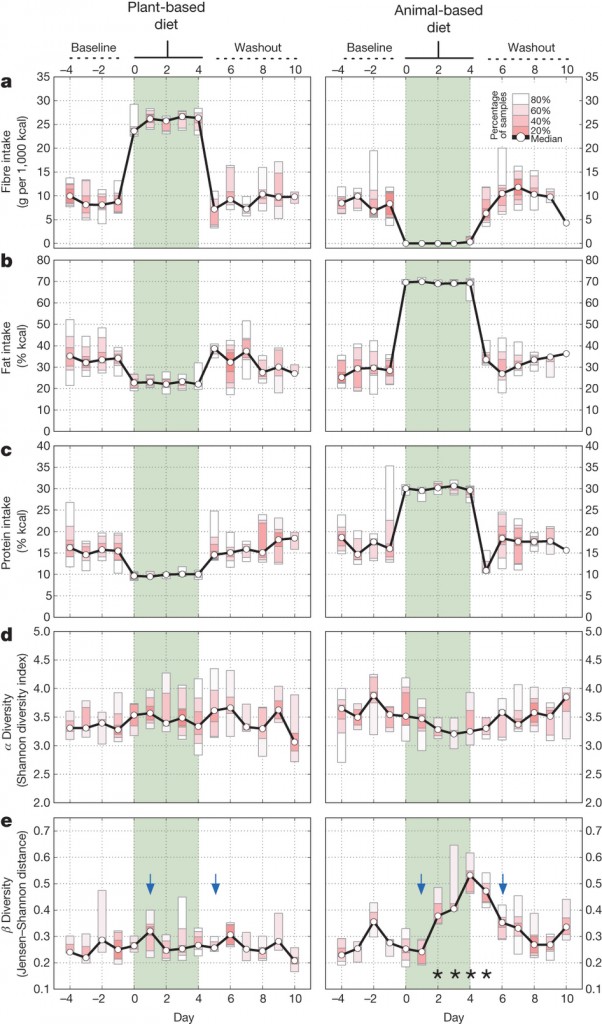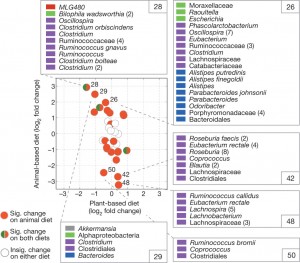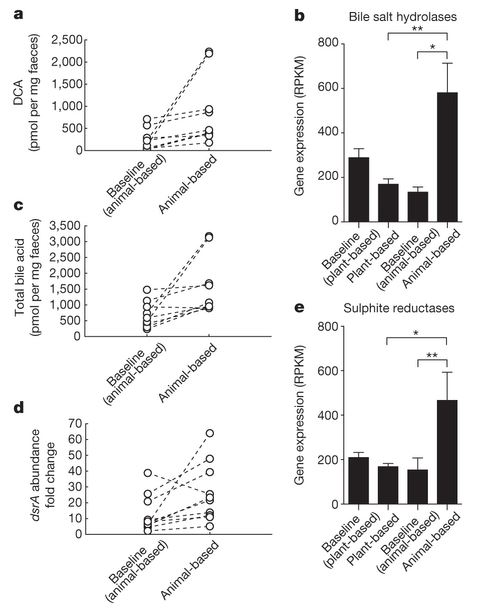Diet changes and the Gut Microbiome
The paper: David, L.A. et al. (2013) “Diet rapidly and reproducibly alters the human gut microbiome.” Nature. doi:10.1038/nature12820
Subject areas: Microbiology
Vocabulary:
microbiome – An ecosystem of microorganisms, primarily but not necessarily exclusively bacteria.
—–
This article is a summary of a recent primary research paper intended for high school teachers to add to their general knowledge of current biology, or to supplement their lessons by showing students the kinds of projects that current biological research addresses.
—–
Gut bacteria have recently become recognized as important players in overall health. There have been many papers that link specific species or ratios of different species of gut bacteria to disorders such as obesity (we reviewed one such paper a few months ago). This paper is novel in that it demonstrates an acute change in human gut bacteria populations in response to a very short-term change in diet. These findings are particularly relevant in a time of growing public concern over obesity and the emergence of numerous diets purporting to combat it. If a diet were to cause a significant shift in the gut microbiome, one could envision that such a shift would have either synergistic or antagonistic effects to the diet change itself.
What they did
In the paper discussed here, David and colleagues investigated diet-related changes in the makeup of the gut microorganisms in ten American subjects (6 male, 4 female) between the ages of 21 and 33, and ranging from normal weight to obese based on body mass index (BMI). The experimental protocol was to start with a four day period during which the subjects ate their normal diet to establish baseline measures. Then there would be a 5-day experimental period in which the subjects ate only a specific provided diet. Following the experimental period, there was a 6 day “washout period” in which a normal diet was resumed to assess recovery of the bacterial populations. Furthermore, on the first and last days of the restricted diets, a small amount of dye was added to the food so the researchers could tell when the food reached the gut.
The two experimental diets were a “plant-based diet” consisting of grains, legumes, fruits and vegetables, and an “animal-based diet” consisting of meats, eggs, and cheeses. The test subjects were allowed to eat as much as they wanted, but were limited to only the prepared foods and either water or unsweetened tea as a drink. Oddly, coffee was allowed on the animal diet, but not the plant diet.
In addition to daily stool samples to analyze bacterial populations and metabolism, the test subjects were also asked to record their food intake, bowel movements, and general notes on health, including any adverse gastrointestinal effects or discomfort.
What they found
 Not surprisingly, there are general nutritional differences between the animal and plant based diets. In this first figure, the top three panels show the differences between plant-based and animal-based diets with respect to fiber, fat, and protein. Compared to their normal diets, people eating the plant-based diets ingested much higher fiber, and lower fat and protein. However, those on the animal diet had lower fiber than the subjects’ usual diets, but much higher fat and much higher protein intake. Surprisingly, even with similar calorie count, people on an animal-based diet showed significant weight loss by the third day of the diet.
Not surprisingly, there are general nutritional differences between the animal and plant based diets. In this first figure, the top three panels show the differences between plant-based and animal-based diets with respect to fiber, fat, and protein. Compared to their normal diets, people eating the plant-based diets ingested much higher fiber, and lower fat and protein. However, those on the animal diet had lower fiber than the subjects’ usual diets, but much higher fat and much higher protein intake. Surprisingly, even with similar calorie count, people on an animal-based diet showed significant weight loss by the third day of the diet.
The crux of the paper is presented in the bottom two sets of graphs. They show diversity of gut microbes: a diversity indicates the diversity within the test subject at that sample time, while b diversity indicates the difference in diversity between the test subjects’ baseline and that taken at sample time. What they found was that while species diversity was not significantly different with diet change, there was a rapid and significant change in the similarity of a subject’s gut biota after starting an animal-based diet to the gut microbiome prior to the diet. Surprisingly, this change in diversity occurred within just one day after the food from the animal-based diet reached the distal gut (far end of the gastrointestinal tube).
In order to refine and better understand their discovery, the researchers did sequence analysis to identify the bacteria found in the stool samples. The graph below shows which populations of bacteria changed the most when a test subject is switched to an animal-based diet. The circles near the middle change very little, and those closest to the top and the bottom of the graph have the greatest increase or decrease, respectively. While 22 different clusters of bacteria showed a significant population shift (from baseline) with an animal-based diet, only 3 clusters of bacteria showed a significant change of population in response to a plant-based diet.
David et al then analyzed the biochemical traits of the bacteria and compared them to the metabolites in the stool samples. They found that there were good correlations between some species of bacteria and higher protein degradation and between other species and carbohydrate breakdown, for example. They also examined gene expression of metabolic enzymes involved in different processes. Interestingly, the animal-based diet was associated with an increase in expression of genes that synthesize vitamins, genes for degrading polycyclic aromatic hydrocarbons (the chemicals made when grilling/charring meat), and b-lactase antibiotic-resistance genes. Furthermore, there were correlations between the bacteria abundant in animal-based or plant-based diets and the bacteria found in carnivorous and herbivorous animals, respectively. In addition to changes in existing populations of gut bacteria, the research group also found that detectable levels of bacteria associated with the production of products like cheeses and cured meats could also be detected in the stool samples.
Finally, the figure below shows the increase in DCA (deoxycholic acid), a secondary bile acid that is associated with DNA damage and liver cancer, when on an animal-based diet. Since DCA is known to inhibit some species of Bacteroidetes and Firmicutes bacteris, it is possible that increased DCA is one cause of the change in gut microbiomes in response to dietary changes.



Comments are closed
Sorry, but you cannot leave a comment for this post.